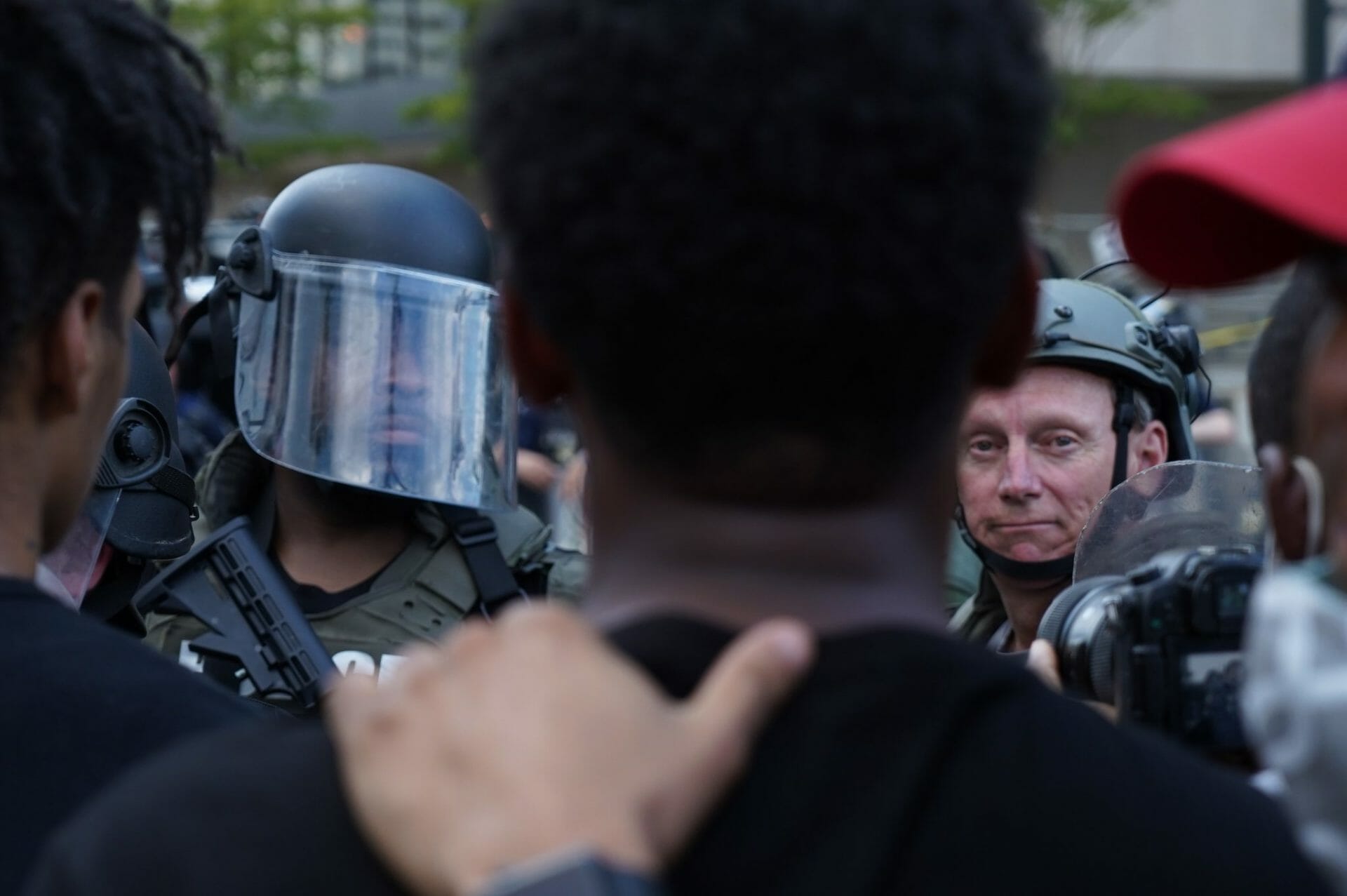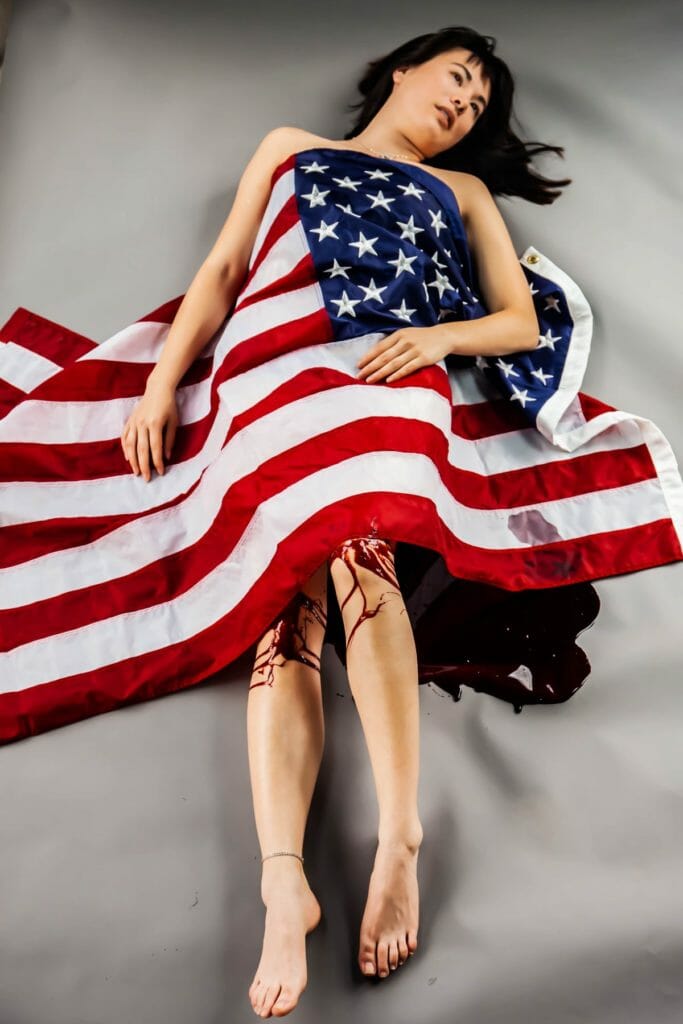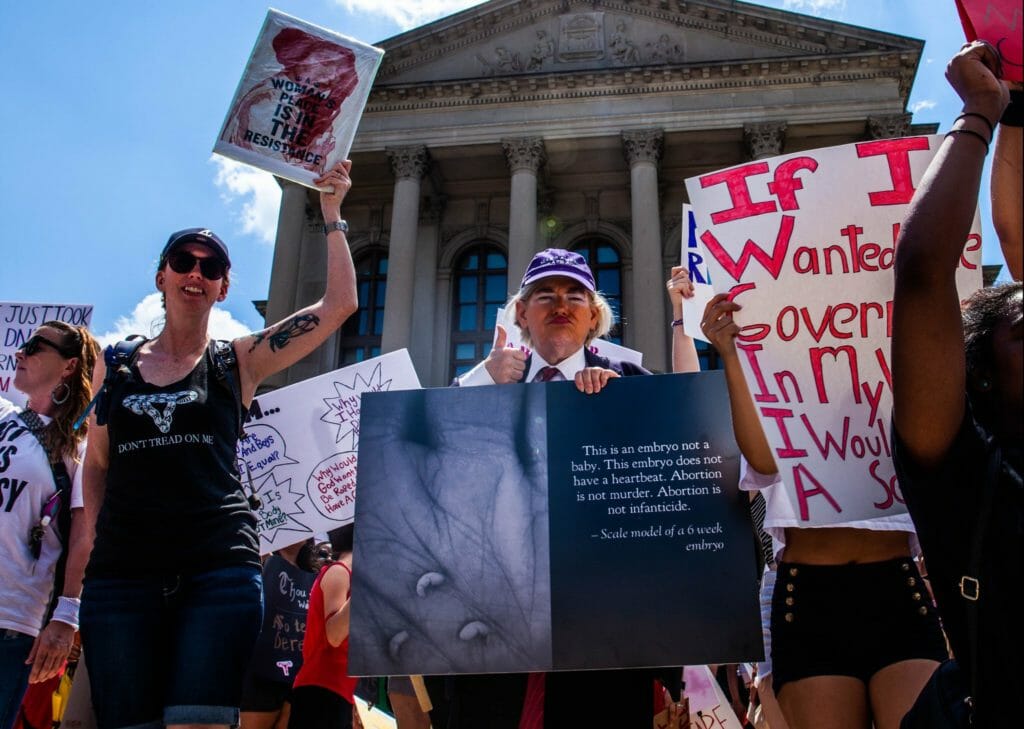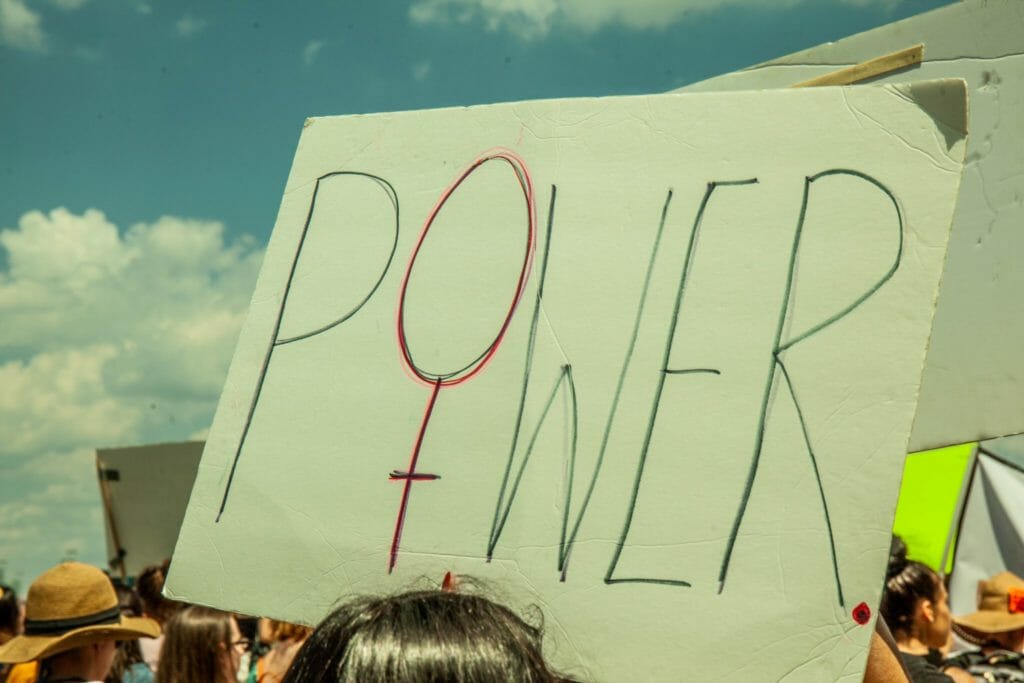The seemingly disparate government responses to coronavirus and to Black Lives Matter make sense in the context of capitalism
Alexi Jenkins is a legal aid attorney, a graduate of Harvard Law School, and a freelance writer.
On Fri., May 29, rapper Killer Mike spoke at an Atlanta city press conference alongside Mayor Keisha Lance Bottoms to address those in the city protesting the May 25 killing of George Floyd, when Minneapolis police officer Derek Chauvin pressed his knee into Floyd’s neck for more than eight minutes until Floyd died of asphyxiation. Protests in response to Floyd’s murder swept the nation in a matter of days. That night in Atlanta, protestors defaced the iconic CNN sign downtown and the city saw an array of property damage, including the College Football Hall of Fame and Del Frisco’s in Buckhead. On the mic in Mayor Bottoms’ press conference during Atlanta’s first night of protest, Killer Mike asked protestors to refrain from looting so that the city may be a place to plan the next moves in the Black Lives Matter movement.
“I am duty-bound to be here to simply say that it is your duty not to burn your own house down for anger with an enemy,” he said. “It is your duty to fortify your own house, so that you may be a house of refuge in times of organization. And now is the time to plot, plan, strategize, organize, and mobilize.” The press conference and Killer Mike’s statements have since gone viral.
Despite his nonviolent appeals, Killer Mike wore a T-shirt stating, “Kill Your Masters,” the title of a 2016 single released by Run the Jewels, the Atlanta-based rapper’s collaborative project with rapper El-P.
The track is entitled “A Report to the Shareholders / Kill Your Masters” on RTJ3, in which the duo raps, “The evening news givin’ yous views/Telling you to pick your master for president/Then behind the curtain, seen the devil workin’,” “[b]orn Black, that’s dead on arrival/My job is to fight for survival/In spite of these #AllLivesMatter-ass white folk,” “got big ideas, got plans to rob/Any Rothschild living, Bill Gates, and the ghost of Jobs.” Here, Run the Jewels confronts the intersections of American government, Black protest, and capitalism in America.
The message on Killer Mike’s shirt is the key to making sense of the federal government’s widely divergent policies in dealing with the coronavirus pandemic and the wave of Black Lives Matter protests across the nation.
The harshness of the government’s response to the protests may appear to be in contrast to its weak coronavirus response, but it is not. State and federal coronavirus responses have been characterized by government concern for profit over people, particularly people of color, who suffer disproportionately more severe illness and death from the virus. The current protests ensuing across the U.S. and the world, while stemmed from the case of George Floyd’s murder, are a widespread response by the people to systemic racism throughout the police force and criminal justice system. The reason the government’s response to the protests was so swift and decisive is because the American system of capitalism has a vested interest in maintaining and perpetuating racism and its underpinning system, white supremacy. Indeed, capitalism and white supremacy are mutually dependent systems.
The measures required to effectively fight coronavirus threatened the supply of workers needed for the American economy to continue to generate increasing profit margins for the ruling class, so these measures were not enacted. Black Lives Matter protests threaten America’s racial and, therefore, economic order, so thousands of National Guard members were called in to intimidate largely peaceful protestors. Over the course of the protests, far more harm has been done by police to protestors than has been done by protestors to the public. Thousands have been arrested, shot with rubber bullets, tear-gassed, and pepper sprayed for the “crime” of peacefully protesting or for being outside at an hour at which it was legal to be outside the day before. Meanwhile, the damage caused by the protests amount to mainly property damage, with few physical injuries inflicted by protestors reported.
The efforts to fight coronavirus and to end systemic racism are both born out of a desire to save human lives. The government response to both crises is born out of a desire to protect business and the economic system as a whole, at the expense of human life. The juxtaposition of these two events makes clear how little our “masters” care for the lives, and the very humanity, of the American people.
The federal government’s response to the coronavirus pandemic has been marred by inaction, with deadly results. As evidence of the seriousness of the virus mounted in early 2020, the Trump administration refused to take action. Meanwhile, other countries throughout the developed world instituted quarantining and mass testing policies, resulting in lower infection and death rates. South Korea, for example, managed to effectively suppress transmission of the virus by instituting widespread testing and quarantining suspected cases, earning praise from the head of the World Health organization. Similarly, Iceland flattened the curve by enacting early quarantine measures and testing more people per capita than anywhere else in the world.
The federal government largely left states to institute their own responses. As of April 6, 42 states had enacted either stay at home or shelter in place orders. The orders came with limited police enforcement. The police enforcement that did occur, in New York City, for example, was so racially disproportionate that it was compared to the city’s infamously racist “stop and frisk” policy. By April 16, Trump and other Republican leaders demanded that states reopen for the sake of the economy, despite robust evidence that reopening would have negative health effects for workers.
On May 1, Georgia’s Republican governor Brian Kemp lifted the state’s shelter in place order, against expert advice and without meeting benchmarks to move into phase one of the Trump administration’s guidelines for reopening. As the number of coronavirus infections continued to increase, Democratic-led states began to follow suit, as leaders of both parties chose to prioritize their states’ economic well-being over public health. On May 12, California’s Democratic governor Gavin Newsom modified the state’s stay at home order, allowing retail, office, service, and outdoor museum spaces to reopen, amid continued concern by public health officials at California’s high infection and death rate. By the end of May, all 50 states had begun opening to some degree, against both public opinion and public health data.
By contrast, state and federal leadership acted swiftly and decisively in response to protests of Floyd’s murder throughout the nation. Floyd was killed by Minneapolis police officer Derek Chauvin on Mon., May 25, when Chauvin pressed his knee into Floyd’s neck for more than eight minutes until Floyd died of asphyxiation. Protests in the city began the next day on May 26, after video of the killing was shared widely on social media. The Minneapolis protests became uproarious in subsequent days, with stores looted and some buildings set on fire. The police responded violently to the protests, firing rubber bullets and tear gas into crowds. The state’s Democratic governor Tim Walz called in the National Guard on May 28 in response to the fires and vandalism only two days after the protests began.
Walz stated, “Let’s be very clear. The situation in Minneapolis is no longer, in any way, about the murder of George Floyd. It is about attacking civil society, instilling fear and disrupting our great cities.” Walz was correct that the “situation” is not only about the murder of George Floyd, but failed to deliver the proper context. He ignored the substance of the protests, which are in whole about dismantling the system of white supremacy in America that made deaths like George Floyd’s possible. He instead demonized the protestors as “attacking” and “instilling fear” in other, “civil” — read: white — segments of society. Furthermore, a “great city” is not one that, like Minneapolis, perpetuates mass incarceration, invests in privatized prisons, and funds a militarized police department with taxpayer dollars. In this one statement, Walz betrayed his fundamental loyalty, and the loyalty of politicians like him around the country, and instead aligned himself with a militarized system of white supremacy.
The chain of events that followed in terms of government reaction to the protests were extremely swift, especially in comparison to its muted response to the deadly and highly transmissible coronavirus, which health expert Dr. Anthony Fauci describes as “his worst nightmare,” that “in a period of four months, has devastated the world.”
On May 27, protests erupted in cities throughout the U.S. On May 29, Trump demanded a cessation of protests and suggested the use of military armed forces to suppress riots. Trump later stated on Twitter, “When the looting starts, the shooting starts,” a phrase with deep segregationist roots. That same day, protests in Atlanta, New York City, and D.C. resulted in destruction of property and police violence. On May 30, multiple cities imposed curfews requiring residents to stay home between certain hours. On May 31, the National Guard was deployed in 23 states and D.C. to quell protests, and multiple mayors extended curfews, as protests and destruction of property continued. On June 1, some cities, including Beverly Hills had curfews as early as 1 p.m. The same day, Trump threatened to deploy the military domestically and promised “total domination” of protesting cities.
If anything, the actions executed by state and local governments in response to the coronavirus pandemic and the George Floyd protests illuminate a desperate desire to return to “business as usual,” even though both events have caused major systemic upheavals, furthering the notion that such a return is impossible. Both national and statewide reactions to the coronavirus pandemic typify ineffective and slow-moving government policies – a definitive underreaction to the state of the crisis. As of June 15 at 9:55 a.m., there have been 2,063,812 million confirmed cases of the virus nationally and 115,271 deaths (those numbers are increasing as you read this). Meanwhile, both national and statewide reactions to the protests typify fast-acting government response – an equally definitive overreaction to the protests. To date, dozens of instances of property damage have occurred since the protests started. Meanwhile, at least 23 states and D.C. activated the National Guard, and there were as many National Guard members activated in the U.S. as there are active duty troops in Iraq, Syria, and Afghanistan. And on June 4, an AP tally found that 10,000 arrests have been made across the U.S. in connection with the George Floyd and Black Lives Matter protests. Meanwhile, the killers of Breonna Taylor, a young Black woman killed in March during a no-knock police raid while she slept in her bed, have yet to be arrested and charged.
Deployment of the National Guard and the imposition of city-wide curfews on short notice (in Atlanta, for example, the 9 p.m. curfew imposed on May 30, was announced via Twitter at 3 p.m. that same day and a phone alert wasn’t sent to city residents until 9:13 p.m.) demonstrate that the government had the ability to enact measures to contain coronavirus, but it simply chose not to. Mayor Bottoms’ press conference the first night of Atlanta’s George Floyd protests proved that she is capable of delivering emotion and passion in heated moments; the concern is what the emotion and passion is directed towards. In the case of May 29, we saw Bottoms shed tears for the defacing of buildings in affluent Atlanta areas such as downtown at the CNN Center and Buckhead. However, after unarmed Black man Rayshard Brooks was killed by police officers at a Wendy’s in south Atlanta late Friday night on June 12, Mayor Bottoms delivered a robotic apology to the family with little to no passion or vigor like what was seen just two weeks prior. When buildings burned in south Atlanta, a historically Black neighborhood, she was nowhere to be found — and neither were the fire departments, according to our sources who attended the protests.
Mayor Bottoms’ responses and leadership during her city’s George Floyd protests, effectively prioritizing the city’s police systems over the well-being of citizens protesting in the streets, is one fragment of a much larger issue: the tendency of American government to place the economy, property, and status quo over human lives. In response to coronavirus, the Trump administration and both Democratic- and Republican-led state governments prioritized economic recovery over the lives of the American people. State governments chose, despite medical evidence to the contrary, to begin reopening states so that business could resume. This further demonstrates that American lives are expendable to the ruling class and limited in value to their usefulness as workers. Businesses needed workers back at work, in spite of the health risks to those workers, and our leaders complied with the demands of business.
In order for capitalism to function effectively, the ruling class needs to convince the vast majority of the population to serve as workers. These workers are integral to the system of capitalism, as they generate profit for the ruling class, or those who hold the means of production. If the ruling class can convince the workers to be happy with fewer and fewer resources, the ruling class can increase its own profit margin. Therefore, the ruling class must constantly work to convince the workers of their satisfaction with an ever-diminishing proportion of the results of their own labor.
In America, workers are largely convinced to accept the terms of the ruling class through the idea that one day, with enough hard work, they too will ascend to the ranks of the ruling class. However, most people have a general awareness that wealth cannot be achieved for each person, as capitalism requires winners and losers in order to function. Certain workers must always be at the bottom, so each individual worker must be convinced that they are not in the bottom class. The American system achieves this perception for white workers, and some workers of color, by maintaining a permanent underclass of Black Americans. If Black Americans are always at the bottom of the economic system, then, according to American capitalism, other workers are free to ascend the economic ladder. This ideology serves to divide the working class.
Dividing white and Black majorities is a timeworn tactic of the American elite, rooted in slavery, as is American capitalism as a whole. During slavery, white plantation owners conscripted poor whites to serve as foremen, inciting them to inflict direct harm on Black enslaved people and placing them in an economically superior position. By pitting Black enslaved people and poor white people against each other, white plantation owners prevented the two disenfranchised groups from uniting in order to overthrow the plantation-owning ruling class. This tactic continued past the end of slavery and into the present era, maintaining the fiction that poor and middle-class white people are only an opportunity away from attaining wealth and power for themselves.
Threatening the racial caste system in America threatens capitalism. If the protests currently sweeping the nation, and the world, were to be successful, white supremacy would be seriously confronted for the first time in our nation’s history. For the ruling class, this confrontation cannot happen if it is to survive. The reason the current people in power are the ones in power is due to the twin evils of white supremacy and capitalism. To erode white supremacy would mean the erosion of American capitalism itself. The two systems are mutually dependent, and we need look no further than our own wallets for confirmation.
As Run the Jewels exhorts on its June 3 release, RTJ4: “The Thirteenth Amendment says slavery’s abolished (Shit)/Look at all these slave masters posin’ on yo’ dollar (Get it?).
We are an independent, largely volunteer-run, women-led publication that provides free coverage to our readers. If you enjoy our work and want to join our mission, donate to help us support the artists and writers who contribute to our platform.




